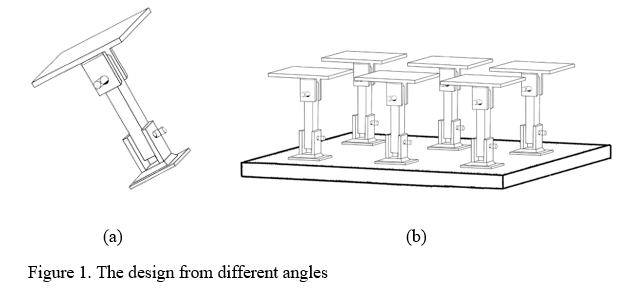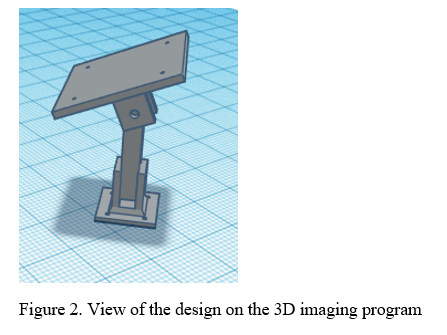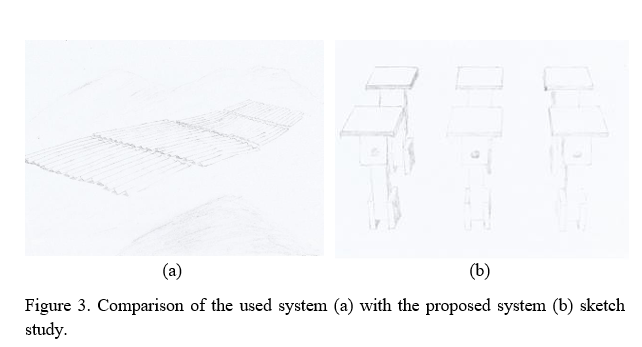Proje Hakkında/ About the Project
- Proje Özeti:
Tarım alanındaki maddi zorluklardan en önemlisi elektrik ihtiyacıdır. Tarlalarda elektrik en çok su motoru için harcanır. Elektrik dağıtım hatlarına uzak olan arazilerde ise elektrik ihtiyacı çiftçi için büyük bir sorun teşkil etmektedir. Yapılan projede bahsi geçen elektrik ihtiyacının yenilikçi güneş paneli montaj aparatı tasarımı ile tarlaya zarar vermeden ve tarım arazisini mümkün olan en az şekilde işgal edip kirletmeden karşılanabilmesi amaçlanmıştır. Burada seçilen arazi de güneş panellerinin kullanılabilir olması açısından önem teşkil etmektedir. Güneş panellerinin kullanılabilir olması için gerekli parametreler şunlardır: yıllık yağış miktarının düşük olması, sissiz bir atmosfere sahip olması, hava kirliliğin olmaması, ormanlık ve ağaçlık bölgelerden uzak olması, rüzgar hızının düşük olması [1]. Çiftçimiz güneş panellerinden elde edilecek elektrikle sulama ihtiyacını karşılayacak, fazla elektriği de dağıtım şirketlerine satarak ek gelir elde edecektir. Geliştirilen montaj aparatı sayesinde güneş panelleri arazide daha az yer kaplamasına karşın, çift eksende güneş takip özelliği sayesinde kullanılan sistemlere nazaran daha fazla enerji verimliliği sağlayacaktır. Panellerin doğru konumlandırılması sonucunda, çiftçi aynı arazide hem elektrik üretebilecek hem de tarlasında mahsulünü yetiştirecektir.
- Tespit Edilen Sorun:
Tarım alanında, ülkemizde çiftçilerin en büyük maddi giderinin elektrik ihtiyacı olduğu; hatta bu ihtiyaç yüzünden çiftçilerimizin belirli dönemlerde bazı yerlerde tarım yapamadığı yapılan saha çalışmaları sonucunda tespit edilmiştir. Bahsi geçen bu yerler elektrik dağıtım şirketlerinin ulaşamadığı yerler ya da elektrik maliyetinin fazla olduğu yerler olup toprağın bereketli olmasına karşın elektrik imkanı bulunamaması sebebiyle sadece yağmur dönemlerinde kısmi tarım yapmaya elverişlidir. Bahsi geçen alanlarda suyu pompalamak için gereken elektrik bulunmadığından sadece mevsimlik olarak ekin ve arpa yetiştirilebilir.
- Çözüm:
Yukarıda bahsedilen sorunların çözümüne yönelik, elektrik olmayan veya elektrik götürmesi maliyetli olan tarım arazilerinde petrol türevi maddelerle çalışan pompalar kullanılmaktadır. Bu sistemler daimi bakım gerektirir ve sadece ulaşımı kolay olan yerlerde kullanılabilirler. Bu sistemlerin alternatifi olarak çevreci ve kolay kullanım bakımından yenilenebilir enerji sistemleri kullanılması gerekmektedir.
Başlıca yenilenebilir enerji kaynakları: hidrolik, güneş, biyokütle, rüzgar, jeotermal, dalga ve hidrojen kaynaklarıdır [2].
Bu kaynaklardan güneş enerjisi ülkemizdeki çoğu tarım arazisi için potansiyel enerji kaynağıdır.
Güneş enerjisiyle çalışan su pompası sistemleri daimi bakım istemedikleri gibi istenilen herhangi bir yerde, düşen güneş ışınlarının verimli olması şartıyla kurulabilirler. Bu tip pompaların ilk kuruluş masraflarının kullanılan diğer sistemlere nazaran yüksek olmasına rağmen, kurulum sonrası masrafları çok düşüktür. Bu nedenle, özellikle güneş potansiyeli yüksek yerlerde kısa süreler içinde daha ekonomik duruma geçerler [3].
Güneş panellerinde yapılan yenilikçi değişimler sayesinde çiftçimiz sulama sistemleri için gerekli olan elektrik maliyetlerini kendileri karşılayabileceği gibi ürettiği enerjiden kalanını elektrik dağıtım şirketlerine satmak yoluyla ek gelir sağlayabilecektir.
Yapılan montaj aparatı üç temel bileşenden oluşuyor: Toprakla temas eden alt montaj parçası, güneş panelini yükselten orta parça ve güneş panelinin monte edileceği üst parça. Bu üç parça, birbirine yarı oynar malzemeler kullanılarak bağlandığı için sistem ayrıca güneş takibi yapabilmektedir. Kullanılan yapı malzemeleri kompozit ve metal türevleridir.
Güneş panellerinin konumlandırılması, fotoğraf 1 ve 2’de de görülebileceği üzere aynı arazide hem elektrik üretmek hem de tarım yapmak için tasarlandı. Bu sayede çiftçiler elektrik ihtiyaçlarını karşılarken güneş panellerinin kurulum yerleri için arazilerinin belirli bölümlerini ayırmak zorunda kalmayacaklardır.
- Projenin Yenilikçi (İnovatif) Yönü :
Şu an kullanılan sistemlerde, sulama için elektrik ihtiyacı olan bölgelerde konvansiyonel enerji kaynakları ile çalışan su pompaları kullanılır [4]. Bahsi geçen enerji kaynakları maliyeti ve çevreye bıraktıkları atıklar sebebi ile kullanılmamalıdır. Buna alternatif olarak bu projedeki sistem, çevreci olması ve bakım maliyetlerinin çok düşük olması sebebi ile kullanılabilir. Ayrıca halihazırda kullanılan güneş enerji sistemlerinin toprağa monte aşamasında beton, çimento ve türevi kimyasal maddeler kullanılmak zorundadır. Bu kimyasal maddeler toprağa ağır metaller saçar. Çimento kullanımı toprakta kadmiyum ve bakır kirliliğine yol açar [5]. Önerilen sistemde, sistemin toprak ile temas yüzeyi düşürülerek bu kirliliğin en az düzeye getirilmesi amaçlanmıştır. Ayrıca çimento gibi kimyasal maddelerin kullanımını en az düzeyde tutmak için sistemin kazık çakma yöntemi ile toprağa sabitlenmesi önerilmiştir. Çoğunlukla kullanılan güneş santrallerinin aksine panelin iki eksenli hareketinin olması, verimi çok büyük ölçüde arttırmaktadır.
- Sonuç ve Öneriler
Yapılan çalışmalardan anlaşıldığı üzere tasarlanan GES (Güneş enerji santrali) tasarımının hali hazırda tarlalarda kullanılan yöntemlere nazaran daha verimli ve çevre dostu olduğu sonucuna ulaşılmıştır. Aynı zamanda tasarlanan güneş panellerinin iki eksenli olduğu ve güneşi takip edebildiği için üretilen elektrik de maksimum düzeyde olmuştur. Kullanılması planlanan malzemenin metal ve kompozit türevlerinden oluşması, güneş ışığını yansıtacağı için sistemin altındaki bitkilerin gelişimine zarar vermeyecektir.
Bu projenin gelişmesi halinde ülkemizdeki güneş enerji potansiyeli daha verimli kullanılacağı için enerjide dışa bağımlılık azalacak ve oluşacak Ar-Ge ortamı sebebiyle maliyetler düşecektir. Ayrıca verilebilecek teşvikler ile çiftçinin yenilenebilir enerjiye yatırım yapması sağlanarak çiftçinin üzerinden elektrik külfeti kalkacaktır. Önerilen sistemin toprakları minimum düzeyde kirletmesi sebebiyle bölge seçimi konusunda esneklikler söz konusu olabilecek ve daha çok alana güneş enerji sistemleri kurulabilecektir.
Projenin fikri mülkiyet haklarını korumak maksadıyla patent başvuru işlemlerine başlanmıştır.
Projenin tasarımı 6769 sayılı Sınai Mülkiyet Kanunu kapsamında tescil edilmiş olunup Türk Patent ve Marka Kurumundaki dosya numarası: 2018 04598’dir.
Projenin ticari değeri bakımından faydalı model tescil başvurusunda bulunulmuştur. İlgili dosya numarası: 2019 03340’tır.
- Kaynakça
- YEGM, 2018, http://www.yegm.gov.tr/yenilenebilir/g_enj_tekno.aspx
- Koç, E., Kaya, K. (2015). “Enerji Kaynakları–Yenilenebilir Enerji Durumu,” Mühendis ve Makina, cilt 56, sayı 668, s. 36-47
- Atay, Ü., Işıker, Y., Yeşilata, B. (2011). Güneş Enerjili Damla Sulama Sistemi Arazi Performansının Deneysel Değerlendirilmesi. Mühendis ve Makina. 53(634):15-20.
- Atay, Ü., Işıker, Y., Yeşilata, B., Fotovoltaik Güç Destekli Mikro Sulama Sistemi Projesi-1: Genel Esaslar, V. Yenilenebilir Enerji Kaynakları Sempozyumu, Diyarbakır, 2009.
- Impact of Soil Heavy Metal Pollution on Food Safety in China Jiangsu Provincial Key Laboratory of Geographic Information Science and Technology, International Institute for Earth System Science, Nanjing University, Nanjing, 210023, China
- Görseller:
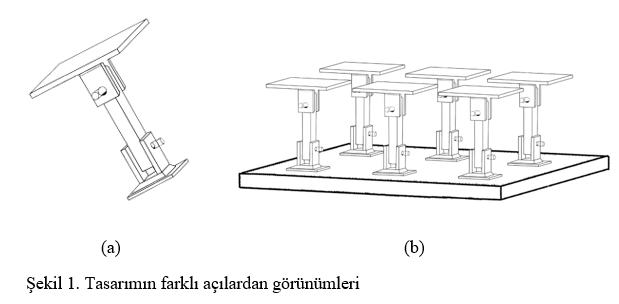
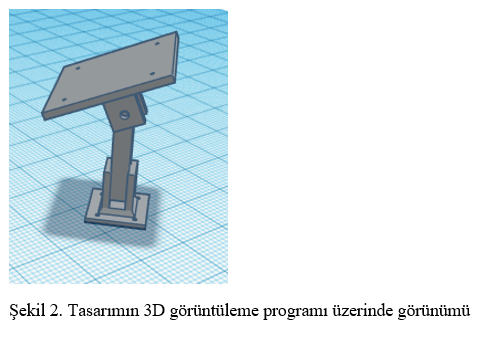
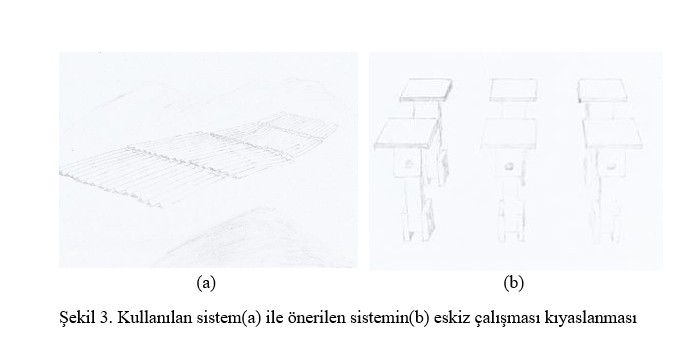
————————————————————————————————-
- The project summary:
The most important financial challenge in agriculture is the need for electricity. In the fields, electricity is mostly used for water engines. In lands far from electricity distribution lines, the need for electricity poses a major problem for the farmer. This project aims to meet the electricity need with the innovative solar panel mounting apparatus design without damaging the field. It will occupy the agricultural land as little as possible without polluting it. The land chosen here is also important in terms of the usability of solar panels. The parameters required for functioning solar panels are: low annual rainfall, having a fog-free atmosphere, no air pollution, being far from forested and wooded areas, and low wind speed [1]. Our farmer will meet the irrigation needs with the electricity obtained from the solar panels, and will earn additional income by selling the excess electricity to distribution companies. Although the solar panels take up less space in the field thanks to the developed mounting apparatus, they will provide more energy efficiency than the systems used owing to the solar tracking feature in the dual-axis. As a result of the correct positioning of the panels, the farmer will be able to both generate electricity and grow his crops in the same field.
- Detected Problem:
In the field of agriculture, the biggest financial expense of farmers in our country is electricity. In fact, the result of field studies has shown that our farmers are not able to farm in certain places due to this need. These are places where electricity distribution companies cannot access or where electricity costs are high. In addition, even though the soil is fertile, they are suitable for partial agriculture only during rainy periods due to the lack of electricity. Crops and barley can only be grown seasonally, as there is no electricity required to pump water in the aforementioned areas.
- Solution:
To solve the problems mentioned above, pumps operating with petroleum derivatives are used in agricultural lands that do not have electricity or are costly to carry electricity to. These systems require constant maintenance and can only be used in places with easy access. As an alternative to these systems, renewable energy systems should be used in terms of being environmentally friendly and practical.
Major renewable energy sources are: hydraulic, solar, biomass, wind, geothermal, wave and hydrogen sources [2].
Among these sources, solar energy is a potential energy source for most of the agricultural lands in our country.
Solar-powered water pump systems do not require permanent maintenance and can be installed in any desired location, provided that the falling sun rays are efficient. Although the initial installation costs of these types of pumps are higher than other systems used, post-installation costs are very low. Therefore, they become more economical in a short time, especially in places with high solar potential [3].
Thanks to the innovative changes made in solar panels, our farmers will be able to meet the electricity costs required for irrigation systems themselves, as well as generate additional income by selling the remaining energy to electricity distribution companies.
The mounting apparatus consists of three basic components: the lower mounting part in contact with the ground, the middle part that raises the solar panel, and the upper part where the solar panel will be mounted. Since these three parts are connected to each other using semi-movable materials, the system can also track the sun. The building materials used are composite and metal derivatives.
The positioning of the solar panels, as can be seen in photos 1 and 2, is designed to both generate electricity and do farming in the same field. In this way, farmers will not have to separate certain parts of their land for the installation locations of solar panels while meeting their electricity needs.
- Innovative Aspect of the Project:
In the systems currently used, water pumps operating with conventional energy sources are used in regions that require electricity for irrigation [4]. These energy resources should not be used due to the cost and the wastes they leave on the environment. Alternatively, the system in this project can be used because it is environmentally friendly and its maintenance costs are very low. In addition, concrete, cement and derivative chemicals must be used in the soil mounting phase of the current solar energy systems. These chemicals scatter heavy metals into the soil. The use of cement causes cadmium and copper pollution in the soil [5]. The proposed system aims to minimize this pollution by reducing the contact surface of the system with the soil. In addition, in order to minimize the use of chemicals such as cement, the system can be fixed to the soil by the piling method. In contrast to the frequently used solar power plants, the biaxial movement of the panel greatly increases efficiency.
- Conclusion and Suggestions
As can be understood from the studies, the designed GES (Solar power plant) design is more efficient and environmentally friendly than the methods currently used in the fields. Furthermore, since the designed solar panels are biaxial and can follow the sun, the generated electricity is also at the maximum level. The material planned to be used consists of metal and composite derivatives and will not harm the growth of the plants under the system as it will reflect sunlight.
With the development of this project, since the solar energy potential in our country will be used more efficiently, the external dependency on energy will decrease and costs will decrease due to the R&D environment that will be formed. In addition, with the incentives, the farmer will be empowered to invest in renewable energy, and the electricity burden of the farmer will be removed. Due to the minimum pollution of the proposed system, there may be flexibility in the selection of the region and solar energy systems can be installed in more areas.
Patent application procedures have been initiated in order to protect the intellectual property rights of the project.
The design of the project has been registered under the Industrial Property Law No.6769 and the file number in the Turkish Patent and Trademark Office is 2018 04598.
A utility model registration application was made in terms of the commercial value of the project. Relevant file number: 2019 03340.
Works Cited
- YEGM, 2018, http://www.yegm.gov.tr/yenilenebilir/g_enj_tekno.aspx
- Koç, E., Kaya, K. (2015). “Enerji Kaynakları–Yenilenebilir Enerji Durumu,” Mühendis ve Makina, cilt 56, sayı 668, s. 36-47
- Atay, Ü., Işıker, Y., Yeşilata, B. (2011). Güneş Enerjili Damla Sulama Sistemi Arazi Performansının Deneysel Değerlendirilmesi. Mühendis ve Makina. 53(634):15-20.
- Atay, Ü., Işıker, Y., Yeşilata, B., Fotovoltaik Güç Destekli Mikro Sulama Sistemi Projesi-1: Genel Esaslar, V. Yenilenebilir Enerji Kaynakları Sempozyumu, Diyarbakır, 2009.
- Impact of Soil Heavy Metal Pollution on Food Safety in China Jiangsu Provincial Key Laboratory of Geographic Information Science and Technology, International Institute for Earth System Science, Nanjing University, Nanjing, 210023, China
- Images:
